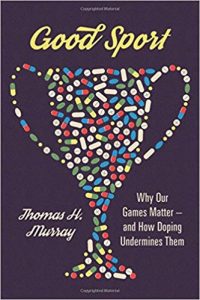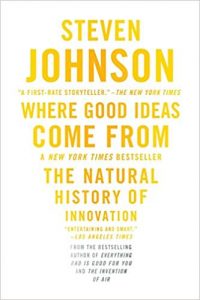Three on the Third is a monthly series in which we highlight three books new to the library collection. Summaries of the books are provided along with shelf location and a link to the item in the catalog. For the month of March, we’re sharing a variety of new items to our collection.
Good Sport
by Thomas H. Murray
 Why are some technologies such as fiberglass vaulting poles and hinged skates accepted in sport while performance-enhancing drugs are forbidden? Yes, performance-enhancing drugs are against the rules, but the people who play and govern sport create those rules; rules can be changed. Should we level the playing field by allowing all competitors to use drugs that allow them to run faster or longer, leap higher, or lift more? In this provocative exploration of what draws us to sport as participants and spectators, Good Sport argues that the values and meanings embedded within our games provide the guidance we need to make difficult decisions about fairness and performance-enhancing technologies. Good Sport reveals what we care about in sport. It describes how the reckless use of biomedical enhancements undermines those values. Implicit in sport’s history, rules and practices are values and meanings that provide a sturdy foundation for an ethics of sport that celebrates natural talents and dedication. The way a sport adapts to innovations in equipment, tactics and players makes visible its values and meanings. Performance-enhancing drugs distort the connection between natural talents, the dedication to perfect those talents, and success in sport. Through understanding the fundamental role of values and meanings, we can see not just what we champion in the athletic arena but more broadly what we value in human achievement.
Why are some technologies such as fiberglass vaulting poles and hinged skates accepted in sport while performance-enhancing drugs are forbidden? Yes, performance-enhancing drugs are against the rules, but the people who play and govern sport create those rules; rules can be changed. Should we level the playing field by allowing all competitors to use drugs that allow them to run faster or longer, leap higher, or lift more? In this provocative exploration of what draws us to sport as participants and spectators, Good Sport argues that the values and meanings embedded within our games provide the guidance we need to make difficult decisions about fairness and performance-enhancing technologies. Good Sport reveals what we care about in sport. It describes how the reckless use of biomedical enhancements undermines those values. Implicit in sport’s history, rules and practices are values and meanings that provide a sturdy foundation for an ethics of sport that celebrates natural talents and dedication. The way a sport adapts to innovations in equipment, tactics and players makes visible its values and meanings. Performance-enhancing drugs distort the connection between natural talents, the dedication to perfect those talents, and success in sport. Through understanding the fundamental role of values and meanings, we can see not just what we champion in the athletic arena but more broadly what we value in human achievement.
Shelf Location: RC1230 .M87 2018
Catalog Link – Good Sport
Damnation Island: Poor, Sick, Mad & Criminal in 19th Century New York
by Stacy Horn
 Conceived as the most modern, humane incarceration facility the world had ever seen, New York’s Blackwell’s Island, site of a lunatic asylum, two prisons, an almshouse, and a number of hospitals, quickly became, in the words of a visiting Charles Dickens, “a lounging, listless madhouse.” Digging through city records, newspaper articles, and archival reports, Stacy Horn tells a gripping narrative through the voices of the island’s inhabitants. We also hear from the era’s officials, reformers, and journalists, including the celebrated undercover reporter Nellie Bly. And we follow the extraordinary Reverend William Glenney French as he ministers to Blackwell’s residents, battles the bureaucratic mazes of the Department of Correction and a corrupt City Hall, testifies at salacious trials, and in his diary wonders about man’s inhumanity to his fellow man. Damnation Island shows how far we’ve come in caring for the least fortunate among us—and reminds us how much work still remains.
Conceived as the most modern, humane incarceration facility the world had ever seen, New York’s Blackwell’s Island, site of a lunatic asylum, two prisons, an almshouse, and a number of hospitals, quickly became, in the words of a visiting Charles Dickens, “a lounging, listless madhouse.” Digging through city records, newspaper articles, and archival reports, Stacy Horn tells a gripping narrative through the voices of the island’s inhabitants. We also hear from the era’s officials, reformers, and journalists, including the celebrated undercover reporter Nellie Bly. And we follow the extraordinary Reverend William Glenney French as he ministers to Blackwell’s residents, battles the bureaucratic mazes of the Department of Correction and a corrupt City Hall, testifies at salacious trials, and in his diary wonders about man’s inhumanity to his fellow man. Damnation Island shows how far we’ve come in caring for the least fortunate among us—and reminds us how much work still remains.
Shelf Location: RC 445 .N68 H67 2018
Catalog Link: Damnation Island
Where Good Ideas Come From
by Steve Johnson
 The printing press, the pencil, the flush toilet, the battery–these are all great ideas. But where do they come from? What kind of environment breeds them? What sparks the flash of brilliance? How do we generate the breakthrough technologies that push forward our lives, our society, our culture? Steven Johnson’s answers are revelatory as he identifies the seven key patterns behind genuine innovation, and traces them across time and disciplines. From Darwin and Freud to the halls of Google and Apple, Johnson investigates the innovation hubs throughout modern time and pulls out the approaches and commonalities that seem to appear at moments of originality.
The printing press, the pencil, the flush toilet, the battery–these are all great ideas. But where do they come from? What kind of environment breeds them? What sparks the flash of brilliance? How do we generate the breakthrough technologies that push forward our lives, our society, our culture? Steven Johnson’s answers are revelatory as he identifies the seven key patterns behind genuine innovation, and traces them across time and disciplines. From Darwin and Freud to the halls of Google and Apple, Johnson investigates the innovation hubs throughout modern time and pulls out the approaches and commonalities that seem to appear at moments of originality.
Shelf Location: BF 408 .J56 2010
Catalog Link: Where Good Ideas Come From
